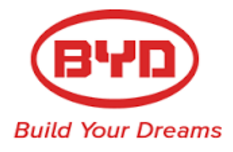China’s lithium-ion
battery and AEV giant BYD has disclosed a massive jump in net profit for the
first quarter of 2018, compared to last year. The company is preparing
to be the leader in the energy change and forecasts massive development in the
next years.

On
April 28, 2018, BYD Company Limited (BYD) published its Q1 financial report.
Specifically, its sales achieved
USD3.89 billion, up by 17.54% YoY. Net loss with non-recurring losses and
gains was USD51.67 million, up by 173.58% YoY. It
also predicted that its net profit in H1 2018 will be USD47.12 million–USD78.53
million, a YoY decrease of 70.98%–82.59%.
According
to market intelligence CCM’s analysis, BYD's alternative energy vehicle (AEV)
business will keep the strong upward trend and maintain a high growth rate in
Q2 2018. However, its overall profitability in the AEV business, including
electrical buses and alternative energy passenger vehicles, will slump compared
to last year because of the subsidy reduction.
The
cost for AEV has decreased greatly after years of development. Profits can be
made from Level A vehicle, given that the subsidy is reduced, and the price of
Level A00 vehicle has fallen to a level almost equal to traditional vehicles.
Obviously, the cost decline is a solid foundation for the policy adjustment.
Now the AEV manufacturers are making profits far higher than traditional
vehicle makers.
In
Q1 2018, China's production and sales of AEV were both booming. According to
China Association of Automobile Manufacturers, the production and sales of AEV
respectively reached 150,000 and 143,000 from Jan.–March 2018, up by 156.90%
and 154.30% YoY. Of this, the respective figure of battery electric vehicle
(BEV) was 108,000 and 102,000, up by 124.70% and 131% YoY, and that of plug-in
hybrid electric vehicles (PHEV) hit 42,000 and 40,000, up by 305.30% and
242.60% YoY.
Although
the sales volume of AEVs in Q1 2017 shrunk from a year earlier due to the
impact of new subsidy policy, BYD believes that the global sales volume grows
steadily in the whole year and will reach 700,000. With the standardization of
AEVs market and the increasing concentration of the industry, China's AEV
market is expected to expand in the future.
BYD's
mobile phone component business progresses steadily as it receives orders for
metallic parts from world-leading mobile phone manufacturers and it achieves
large-scale production of glass phone cases.
In
2017, China's subsidy on AEV started linking up with the energy density of
power battery. Under this, ternary material gradually became a trend in the
market — most of the domestic battery cell manufacturers shifted their focus
from lithium-iron material to ternary material. So far, over 80% of the power
battery producers who originally gave priority to lithium-iron battery have
developed their ternary material business, such as BYD.
Specifically,
the Chinese administration will support the development of fuel battery vehicle
and encourage the development of BEV and premium marketed passenger PHEV. In
addition, it will further improve the requirements on the energy density for
passenger BEV. The subsidy for AEV will be offered by phases in 2018, which
will contribute to the continued and effective supply and demand of AEV. That
is to say, the AEV business will develop in a relative
BYD to restructure for
revenue of over USD150.83 billion in 2025
In
November, BYD announced the medium-and long-term plan and its development goal
and reform ideas at the executive conference. First, BYD would be forged to be
a century-old company. Second, in around 2025, the total revenue of BYD would
reach at least USD150.83 billion. Third, a new brand mission was
released-meeting people's expectation for bright future through technological
innovation.
Additionally,
to match the reform of achieving the revenue, an institutional reform would be
carried out inside BYD. As divided into different businesses, an institutional
structure of "business group+ business division" would be established
to make the best of every group. New profit drivers must be found and new
growth points are nurtured. Therefore, BYD has broken the walls between
segments and divisions so as to speed up organization operation and react
promptly to the market.
BYD
sees itself not simply a battery company or vehicle company. Currently,
defining itself as a pathfinder in the new energy industry, BYD owns business
groups in Skyrail, passenger car, business car, electronics, battery, etc. As
CCM analyzed, there are mainly three segments that can bring profit to BYD,
namely Skyrail, battery and other components and alternative energy vehicles.
As
for the AEVs, BYD is currently deploying the AEV business worldwide. According
to the marketing strategy of AEV "7+4" released in 2015, its products
include private cars, city buses, taxis, road buses, city logistics cars for
goods delivery and city logistics cars for construction, sanitation vehicles
and four kinds of dedicated cars. Reportedly, from January to Oct. 2017, BYD
sold 82,859 new energy passenger cars, ranking first in the industry.
CCM
believed that with the fierce competition in AEV industry, BYD would maintain
the first place in the market through three main businesses. As been considered
as the leader in AEV industry, abroad, BYD is confronted with the competition
with Tesla and crisis of being surpassed by Contemporary Amperex Technology at
home, which urges it to increase the operating revenue by seeking larger market
share. Compared with other companies, BYD possesses an absolute advantage in
technique and market and should cut down the production cost in terms of AEVs
while enhancing the energy density in Li-ion battery field.
About the article
The
information for this article comes from CCM, China’s leading market intelligence
provider for the fields of chemicals, energy, agriculture and life science.
Get
regular and exclusive insights into China’s energy and AEV market by
subscribing to CCM’s monthly published Li-ion Battery China News.
Take
part in the discussion by joining our groups on LinkedIn and Facebook.
Follow
CCM on Twitter: @CCM_Kcomber